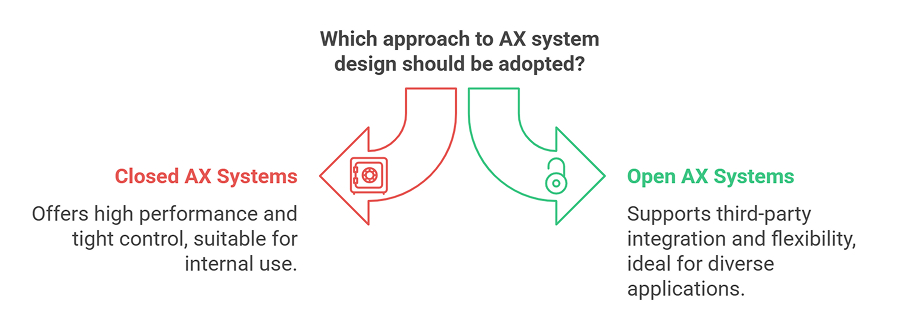As artificial intelligence (AI) becomes more common, the way software interacts with users is changing. It’s no longer just about people using software directly. AI-powered systems are now taking action on our behalf. This shift has led to a new idea called Agent Experience (AX).
AX builds on user experience (UX) and developer experience (DX) but focuses on what AI agents need to work effectively.
AI Agents
AI agents are software programs that use AI to learn, make decisions, and take actions autonomously in an environment to achieve specific goals on behalf of the user.
Furthermore, AI agents can be categorized based on how they understand, learn, and take action to complete tasks.

1. Simple Reflex Agent
- Follows predefined rules (known as condition-action rules) to respond to situations without future consequences and past experiences.
- Example: a thermostat that turns the heater on/off based on the temperature.
2. Model-Based Reflex Agent
- Keeps a basic memory of what’s happening around them so they can react more smartly even if they don’t learn like humans.
- Example: A cleaning robot that remembers room layouts and past movements to navigate the room.
3. Goal-Based Reflex Agent
- Works toward a specific goal by choosing actions that bring it closer to that goal.
- Uses planning to pick the best path forward.
- Example: A GPS system that looks at all possible routes and picks the best one to reach your destination.
4. Utility-Based Agent
- Thinks ahead by weighing different outcomes and choosing the one with the highest overall value based on multiple factors.
- Example: A self-driving car that balances speed, fuel use, and safety to find the best route, not just the fastest one.
5. Learning Agent
- Learns from past experiences and feedback to improve how they perform tasks over time.
- Example: Some chatbots and recommendation systems adjust based on user behavior and input.
Importance of AX
While poor UX frustrates users and bad DX slows down developer productivity, poor AX can reduce the effectiveness of AI agents. That’s why designing for agent experience (AX) is becoming increasingly important-it can have a real impact on both the strategic value and day-to-day performance of software systems.
- Speed and productivity: A well-designed AX helps AI agents process information efficiently and take action quickly. It reduces unnecessary API calls, misinterpretations, and retries caused by poor data structure or unclear system behavior.
- Reliability: Good AX design enables agents to better handle unexpected scenarios or edge cases, leading to more stable systems and improved user trust.
- Composability: AI agents often interact with multiple services-or even other agents. Hence, AX should promote interoperability and consistent behavior across systems.
- Maintainability and adaptability: As systems evolve, agents should be able to adapt without breaking. This means clear versioning, backward compatibility, and reliable indicators when something changes.
Open vs. Closed Approaches
There are two main approaches to consider when building systems with AX.

1. Closed AX Systems
Closed AX systems are usually built for internal use and are tightly integrated and controlled. This allows them to offer high performance and efficient communication between system components
These systems are often used in vertically integrated products, where everything is built and maintained by a single organization.
Examples:
- Apple Siri, which accesses a controlled set of APIs
- Tesla Autopilot, which operates within a custom, closed vehicle environment
However, closed systems limit flexibility because they don’t easily allow external agents to connect or interact.
2. Open AX Systems
Open AX systems are designed to support external agents. Instead of being tailored to a single AI system, they follow open standards that make them accessible to third-party and internal agents alike.
These systems emphasize:
- Discoverability
- Clear and comprehensive documentation
- Long-term interface stability for reliable integration
Examples:
- APIs built with OpenAPI specifications
- Semantic web standards (for structured, machine-readable data)
- AI frameworks like LangChain or AutoGPT that support a wide range of general-purpose AI agents
How Can You Design a Better AX?
Designing for AX means rethinking how software interacts-not just with users and developers but with AI agents, too. Here are some best practices to help create a better customer experience agent.
1. Use clean, structured data
AI agents don’t respond to visuals like humans do. They work best with well-structured, machine-readable data. Design systems that provide clear, consistent formats to reduce confusion and unnecessary processing.
2. Build clear, well-documented APIs
APIs are how agents take action. Make sure your APIs are easy to understand, stable over time, and thoroughly documented so agents can use them effectively without guesswork.
3. Make onboarding simple-for both humans and agents
The first-time experience matters. Make it easy for agents to get started and simple for users to set things up. When the onboarding process is smooth, people are more likely to trust and rely on the agents.
4. Enable human oversight when needed
Even smart agents need a human in the loop for critical actions like approving financial transactions or handling sensitive data. In such cases, the system should be designed so the agent can pause and request human approval.
Conclusion
As generative AI becomes more common, software systems increasingly rely on AI agents to perform tasks on their own. Just as user experience (UX) and developer experience (DX) are key to building great digital products, it’s now just as important to consider agent experience (AX).
A well-designed AX ensures that AI agents can interact with systems efficiently, reliably, and intelligently, leading to better performance and more meaningful outcomes.
